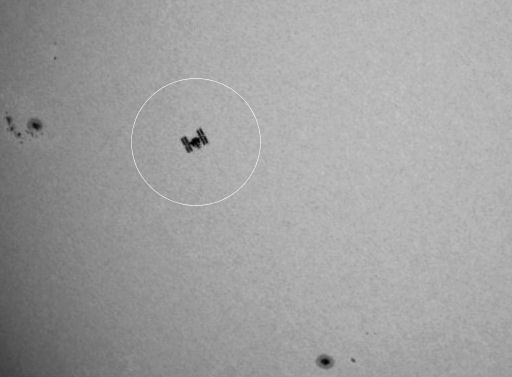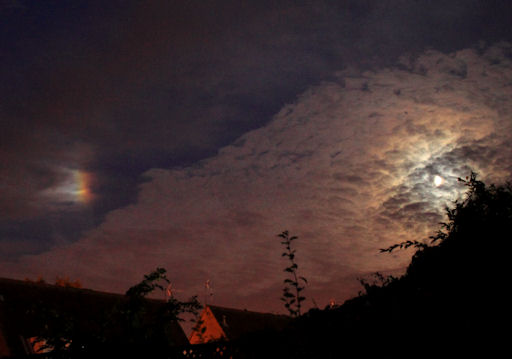QUIET SUN: Except for some minor rumblings on the sun's northeastern limb, solar activity is very low. The sun's X-ray output has nearly flatlined and NOAA forcasters put the odds of a major flare today at less than 10%.
FAST-MOVING SUNSPOT: Today in the blue skies above Scarborough Marsh, Maine, a dark-winged shape flitted across the face of the sun. It was the International Space Station:
"The ISS cut across the sun, transiting the entire solar disk in only 7/10th of a second," says amateur astronomer John Stetson who photographed the passage with split-second timing. "In today's transit the ISS appeared to be 54 arc seconds in angular diameter." In other words, it subtended an angle about the same as the planet Jupiter. Because the ISS is so large, it is possible to see the details of its structure through backyard telescopes. Here's a telescope that works both during the day and at night.
Stetson notes that is this a good week for ISS flybys of the United States. When it is not transiting the sun, the space station typically appears in the evening sky shining as brightly as Venus or Jupiter. A transit of the entire sky takes about five minutes, so finding and tracking the behemoth spacecraft is easy if you know when to look. ISS flyby alerts: text, phone (Note to subscribers: Select the "backyard astronomy" option.)
WATCH OUT FOR MOONDOGS: The moon is waxing full this week, which means it's a great time to look out for moondogs. They appear 23 degrees from the moon, splashes of light shining with the colors of a rainbow, but they are not rainbows. Barry Starling of Histon UK photgraphed this specimen on August 25th:
Unlike rainbows, which are caused by raindrops, moondogs are caused by ice crystals. Even during the summer, high clouds are cold enough for water in them to crystallize. When moonlight shines through the icy clouds, voila!--a moondog. High-altitude ice crystals can also make moon haloes and pillars, so watch out for them, too.

![]()
Solar wind
speed: 460.8 km/sec
density: 0.3 protons/cm3
explanation | more data
Updated: Today at 1537 UT
![]()
X-ray Solar Flares
6-hr max: B3 1256 UT Aug28
24-hr: B6 0307 UT Aug28
explanation | more data
Updated: Today at: 1500 UT
![]()
![]()
![]()
Daily Sun: 28 Aug 12
![]()
![]()
None of these sunspots poses a significant threat for strong flares. Credit: SDO/HMI
![]()
![]()
![]()
Sunspot number: 85
What is the sunspot number?
Updated 28 Aug 2012
Spotless Days
Current Stretch: 0 days
2012 total: 0 days (0%)
2011 total: 2 days (<1%)
2010 total: 51 days (14%)
2009 total: 260 days (71%)
Since 2004: 821 days
Typical Solar Min: 486 days
Update 28 Aug 2012
The Radio Sun
10.7 cm flux: 112 sfu
explanation | more data
Updated 28 Aug 2012
![]()
![]()
![]()
Current Auroral Oval:
![]()
Switch to: Europe, USA, New Zealand, Antarctica
Credit: NOAA/POES
![]()
![]()
![]()
Planetary K-index
Now: Kp= 1 quiet
24-hr max: Kp= 2 quiet
explanation | more data
![]()
Interplanetary Mag. Field
Btotal: 4.1 nT
Bz: 2.5 nT north
explanation | more data
Updated: Today at 1536 UT
![]()
![]()
![]()
Coronal Holes: 28 Aug 12
![]()
![]()
There are no large coronal holes on the Earthside of the sun. Credit: SDO/AIA.






